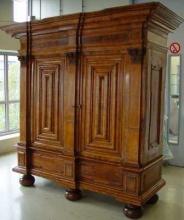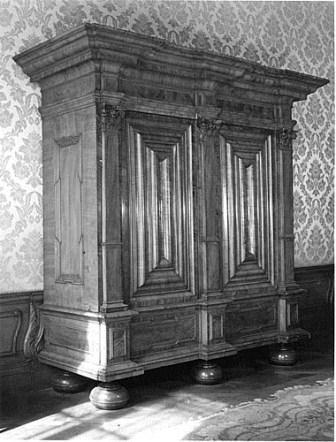On 6 December 2002 the State Secretary of Culture asked the Restitutions Committee for advice on the decision to be taken concerning the application for restitution of an 18th century so-called ‘Frankfurt’ cupboard (NK 986). This application was submitted to the State Secretary on behalf of the heirs of Mr and Mrs L. on 8 November 2002. In a letter to the Restitutions Committee, dated 14 January 2003, the applicant stated that she had recognised the cupboard from a photo as having previously been her (Jewish) parents’ property. She added that she no longer had proof to substantiate her claim: when the family returned after the war from the camp where they had been interned there was practically nothing left of the contents of their house in Amsterdam. The applicant stated that she had heard from a fellow prisoner in Camp Westerbork that the contents of her parents’ house had been seized by the Nazis and because of the many valuable items taken directly to Hitler’s headquarters.
The information about the provenance history of the cupboard with registration number NK 986, as determined by the investigation carried out by the Origins Unknown Agency (BHG), starts in 1948. It proved impossible to find information about the period before then. However, the NK inventory number does suggest that the cupboard was discovered in Germany after Germany surrendered in 1945, that it was determined on the basis of the information available at the time to ‘originate from the Netherlands’ and that it was therefore allocated to the Netherlands. In 1948 the Netherlands Art Property Foundation (SNK) loaned the cupboard to the embassy in Berlin and then to the embassy in Bonn before it finally ended up at the Ministry of Defence in The Hague. The investigation showed that this was the only so-called ‘Frankfurt cupboard’ in the NK collection. The following is known about the events surrounding the family’s loss of possession of the cupboard. The investigation turned up a document dating from 1957, in which the applicant’s mother from the United States listed the property stolen from her house during the war. This list includes a ‘Frankfurt cupboard’. The Committee concluded from this that the family in any case owned a Frankfurt cupboard. In order to gain a better insight into the possibility of identifying the cupboard with registration number NK 986, the Committee turned to a furniture expert. Dr. R. Baarsen, conservator at the Rijksmuseum in Amsterdam, described the cupboard as “…an example of a storage cabinet of which a large number were manufactured in the period 1690-1760” but added that the item in question had a number of unusual characteristics, which “…make it fairly exceptional and easily recognisable…”. In his opinion, a picture of the cupboard – even if it showed just a small section of the cupboard that corresponded completely to NK 986 – would be enough to determine the identity of the cupboard. However, neither the applicant nor her family had any photos. Nevertheless, the applicant was able to remember a number of characteristics of the cupboard. Although not unique, these were not visible on the photo that the applicant had seen and did correspond to the cupboard registered as NK 986.
The Restitutions Committee adopted its advice at its meeting on 18 September 2003. Its conclusion was that the Frankfurt cupboard with inventory number NK 986 should be handed over to the heirs of Mr and Mrs L. who were the applicant’s parents. The Committee’s advice took account of the fact that it was impossible to conclusively identify the Frankfurt cupboard (NK 986) as the former property of the applicant’s family, if only because the cupboard was a generic item. However, based on the results of the investigation and given the lack of evidence to the contrary, the Committee concluded that the family’s right of ownership of the cupboard was sufficiently plausible. In this regard the Committee referred to its general consideration that since it was plausible that the period of time that had lapsed was partly the reason for the proof problems that had arisen, the related risk should be borne by the government. On 11 November 2003 the State Secretary decided according to the Committee’s advice to grant the request for restitution of the Frankfurt cupboard, which had been number NK 986 in the Dutch National Art Collection.

